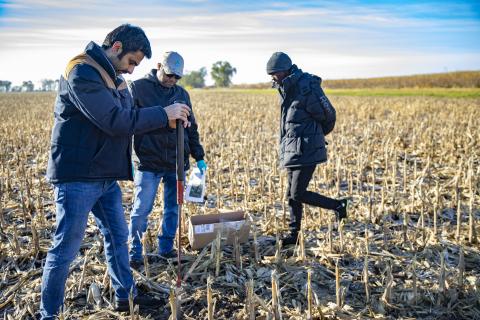By Callie Svoboda, Business and Marketing Intern, Water Sciences Laboratory, University of Nebraska-Lincoln
Photo Caption, Right – A research team from the University of Nebraska-Lincoln digs into a cornfield near Mead, NE in November to collect soil samples. The team is part of a larger research collaboration to understand the breadth and depth of contamination from the AltEn ethanol facility.
It’s a frosty early November morning in a cornfield near Mead, Nebraska.
Here, Patrick Niyitugize is pounding a soil probe into land on the University of Nebraska-Lincoln’s Eastern Nebraska Research, Extension and Education Center (ENREEC). As it happens, a two-lane highway is all that separates ENREEC’s property line from the now defunct AltEn ethanol plant, making it an ideal location to understand contaminant transport downstream. Niyitugize, a senior from Rwanda studying integrated science, is one of roughly a dozen students and postdocs working alongside 13 faculty researchers at Nebraska, the University of Nebraska Medical Center and Creighton University to assess the scope of contamination stemming from AltEn. Joining him are Shahab Karimifard, a postdoctoral associate in UNL’s Department of Civil and Environmental Engineering and Arindam Malakar, a research assistant professor with the Nebraska Water Center.
“Initially, it was mostly the surface water sampling,” Malakar explained of the research. In early 2021, the team started sampling creek water running from AltEn into ENREEC’s property and found high amounts of contamination.
“We started to realize this is a bigger problem than just surface water contamination. That led to the thinking of how badly the soil might be affected. This is what we are trying to answer today,” Malakar said.
When it started operating in 2015, the plant represented an innovative way to generate ethanol from feedstocks consisting almost entirely of leftover seed corn treated with pesticides and fungicides. Treated seed is not unusual; but using it in large volumes to produce ethanol is. Over time, area residents became concerned as fish, bees, and house pets fell ill and died. Residents themselves endured a stench in the air, burning eyes and breathing difficulties.
The discarded seeds were treated with neonicotinoid insecticides – a popular protection against a broad spectrum of pests. While neonics, as they’re known, target insects with a lethal efficiency, there is a growing body of research pointing to toxic impacts on non-pest species, including bees and deer. Furthermore, a large percentage of these chemicals find their way to other parts of the environment, such as surface water and untreated plants. In places like Mead, the human health impacts of neonics are surfacing. Understanding the extent of their toxicity to humans takes dedicated research and cutting-edge laboratory analysis.
Enter the Nebraska Water Center’s Water Sciences Laboratory. The lab is the primary destination for all water and soil samples collected through this research. A committed group of students and full-time technicians, including Niyitugize, operate its high-powered equipment using sophisticated methods. He says the lab has been “a good opportunity to learn the whole process of sampling, analyzing, and then evaluating the data.”
The overall goal of the project is to figure out the extent of contamination within the surrounding land, air, water, and animals. According to Karimifard, “The team will continue to monitor all aspects of the environment affected and have more decisive results in the near future.”
To the naked eye, these fields look the same as they always do. But on this chilly November morning, these three University of Nebraska researchers are digging deeper. What emerges from their investigation will help answer critical questions – for both the people of Mead and future communities exposed to contamination. What’s in our water? What does this mean for our health?

